During a major test, the drone acted as an airborne translator for the F-22 and F-35, while also flying in formation alongside them.

The U.S. Air Force has successfully demonstrated the ability of a new communications and data gateway, designed in part to be installed on a specially configured XQ-58A Valkyrie drone, to allow the service’s F-22 and F-35A stealth fighters, as well as the rest of the Joint Strike Fighter family, to exchange information stealthily. During these tests, the Valkyrie — designed as a lower-cost, stealthy unmanned aerial vehicle — also achieved a semi-autonomous flight alongside the F-22 and F-35s for the first time.
The low probability of intercept (LPI) datalinks on the F-22 and the F-35 series cannot “talk” to each other directly, meaning the two types use different waveforms and hardware to communicate among their own kind. Using a gateway, it is possible to receive both data streams, fuse that information, and then broadcast it back to each aircraft within line-of-sight. This gives pilots the whole picture of where everyone else is, what they are doing, and what they are seeing on their sensor systems, while also allowing them to communicate with each other. Using a stealthy drone to do this is a new and a far more attractive and relevant option than using lumbering converted airliners or pods strapped on a non-stealthy combat jet.
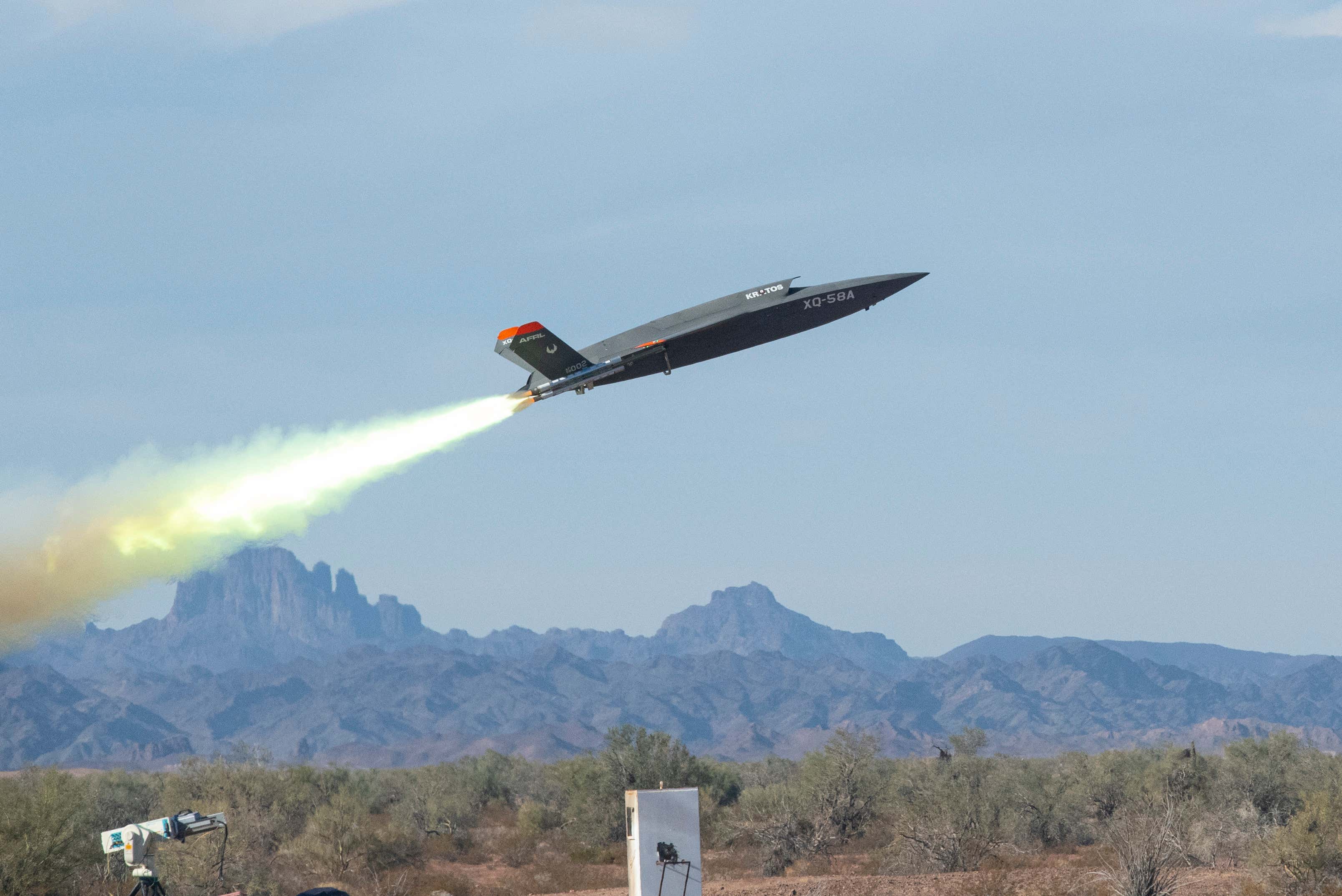
The Air Force-led trial, which the service has billed as a precursor to establishing a military “Internet of Things,” was intended to help address the problems previously encountered in exchanging data between different fifth-generation fighter platforms. The new data-sharing and communications relay system on the XQ-58A, as well as this particular configuration of the drone, are being developed under the service’s gatewayONE and attritableONE efforts, respectively. These, among dozens of other projects, are all part of the overarching Advanced Battle Management System (ABMS) program, which promises to bring open architecture to the battlefield, the implications of which The War Zone has discussed extensively in the past, including here and here.
In an Air Force release published yesterday, the service announced details of the experiment, which was run at Yuma Proving Ground, Arizona, last week, following preliminary tests at Nellis Air Force Base, Nevada. The highlight of the multi-faceted event was integrating the gatewayONE payload on the service's second XQ-58A vehicle, serial number 15-8002.
The Air Force had announced the first-ever flight of an XQ-58A last year, which was performed by its initial Valkyrie, serial number 15-8001. That particular unmanned aircraft had been delivered to the Air Force Research Laboratory (AFRL) as part of its Laboratory's Low-Cost Attritable Aircraft Technology (LCAAT) program, which has served as a stepping stone to the Skyborg project. The Air Force has said that there is close coordination between the Skyborg, which is focused on the development of an artificial intelligence-driven “computer brain” capable of flying semi-autonomous “loyal wingman” type drones and fully-autonomous unmanned combat air vehicles (UCAV), and attritableONE efforts. Kratos, which makes the XQ-58A, is involved in the Skyborg program and recently received a new contract to build prototype drones to carry those systems.
“Testing is all about pushing the limits of what’s possible, finding out where the toughest challenges are, and adapting creative solutions to overcoming difficult problem sets,” Air Force Lieutenant Colonel Kate Stowe, the gatewayONE program manager at the Air Force Lifecycle Management Center (AFLCMC), said. “The real win of the day was seeing the gatewayONE establish a secure two-way translational data path across multiple platforms and multiple domains. That’s the stuff ABMS is all about.”
Lieutenant Colonel Stowe added that out of 18 test objectives, nine were successfully achieved. Despite the breakthrough of integrating the gatewayONE payload with the XQ-58A, it is clear that not all went entirely according to plan. Shortly after takeoff during the milestone December 9 flight, “the communications payloads lost connectivity and those test objectives were unable to be accomplished,” according to the Air Force. With that in mind, it is not clear as to what degree meaningful data-sharing occurred. However, Lieutenant Colonel Stowe’s above statement confirms that the gatewayONE did establish a two-way data link across multiple platforms.

A control-room operator observes a test prior to an XQ-58A Valkyrie launch at the U.S. Army Yuma Proving Ground, Arizona.
The major obstacle to having the F-22 and F-35 “talk” to one another is the different digital “languages” and waveforms that their stealthy datalinks use. While the F-22 is equipped with the Intra-Flight Data Link (IFDL), the F-35 employs the Multifunctional Advanced Data Link (MADL). Traditionally, if pilots of these different aircraft needed to share data with each other inflight, or transmit it to a command and control center, they would have to utilize legacy tactical connections, such as Link 16, which are non-stealthy. Link 16 broadcasts omnidirectional and they are more easily detectable by enemy forces, giving up the advantage of stealth. The F-22, for instance, still cannot broadcast on Link 16 at all, but it can receive information from it. You can read more about these different stealth fighter data links, how they work, and the challenges of integrating their data in this previous article.
Essentially, the job of gatewayONE is to “translate” between these incompatible data-link formats. Instead of transmitting the information first to an operations center or tactical ground node, the Yuma experiment used a payload onboard the XQ-58A to do the translation and to rebroadcast it back to the airborne fighters.
Last November, Will Roper, the Assistant Secretary of the Air Force for Acquisition, Technology, and Logistics outlined the gatewayONE plan, describing it as part of a “connect-a-thon” rapid experimentation concept. You can read more about the overall thinking behind it here.
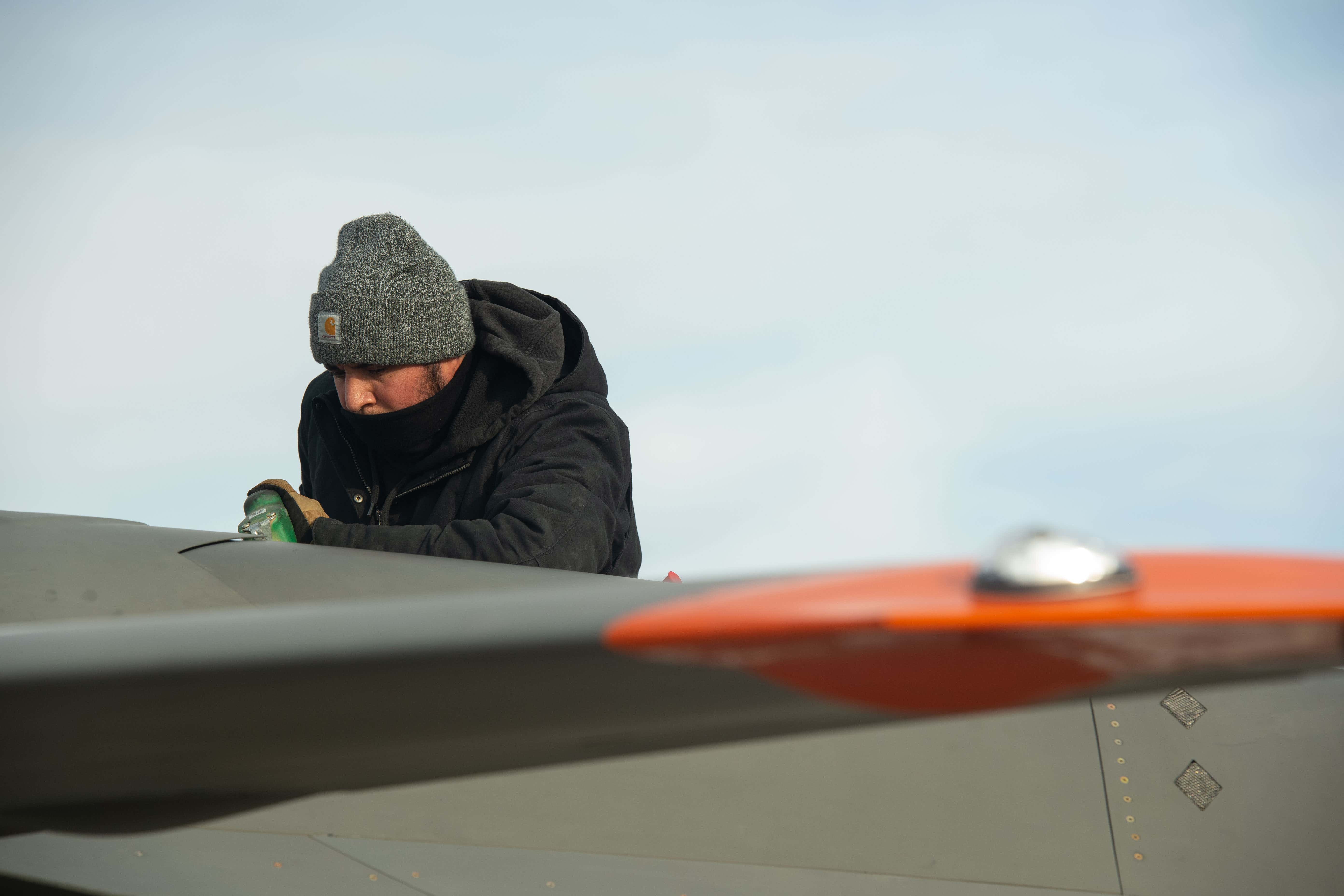
An XQ-58A Valkyrie maintainer pours fuel into the aircraft on a launchpad at the U.S. Army Yuma Proving Ground, December 9, 2020.
“Additionally, the test pushed the position data of each platform outside of the aircraft’s close-proximity formation through gatewayONE, which enables battle managers on the ground or in the air to better orchestrate operations,” the Air Force release added. “The gatewayONE payload also passed tracks or cues from ground operators to both fighters and passed a cue from the F-35A to the F-22 for the first time. These bi-directional communications pathways occurred in the platforms’ native digital “languages” and the data was displayed through the aircraft’s organic systems.”
Again, this is conclusive on the point that there was data transfer between the jets, enabled by the Valkyrie, but it remains possible that some of this might not have been achieved during the December 9 flight. Instead, aspects of these accomplishments could have been achieved by the gatewayONE package on the ground or in a flying surrogate aircraft. It just isn't clear at this time.
“The gatewayONE payload really showed what’s possible and helped us take a big step towards achieving [Joint All-Domain Command and Control],” added Lieutenant Colonel Eric Wright, an F-35A pilot with the Air Force’s 59th Test and Evaluation Squadron. “This critical capability provides additional connections between our advanced fighters and other forces and battle managers across all domains. The future is promising, and gatewayONE will allow the F-22 and F-35 to connect to and feed data sources they’ve never before accessed. Those future connections will bring additional battlefield awareness into the cockpit and enable integrated fires across U.S. forces.”
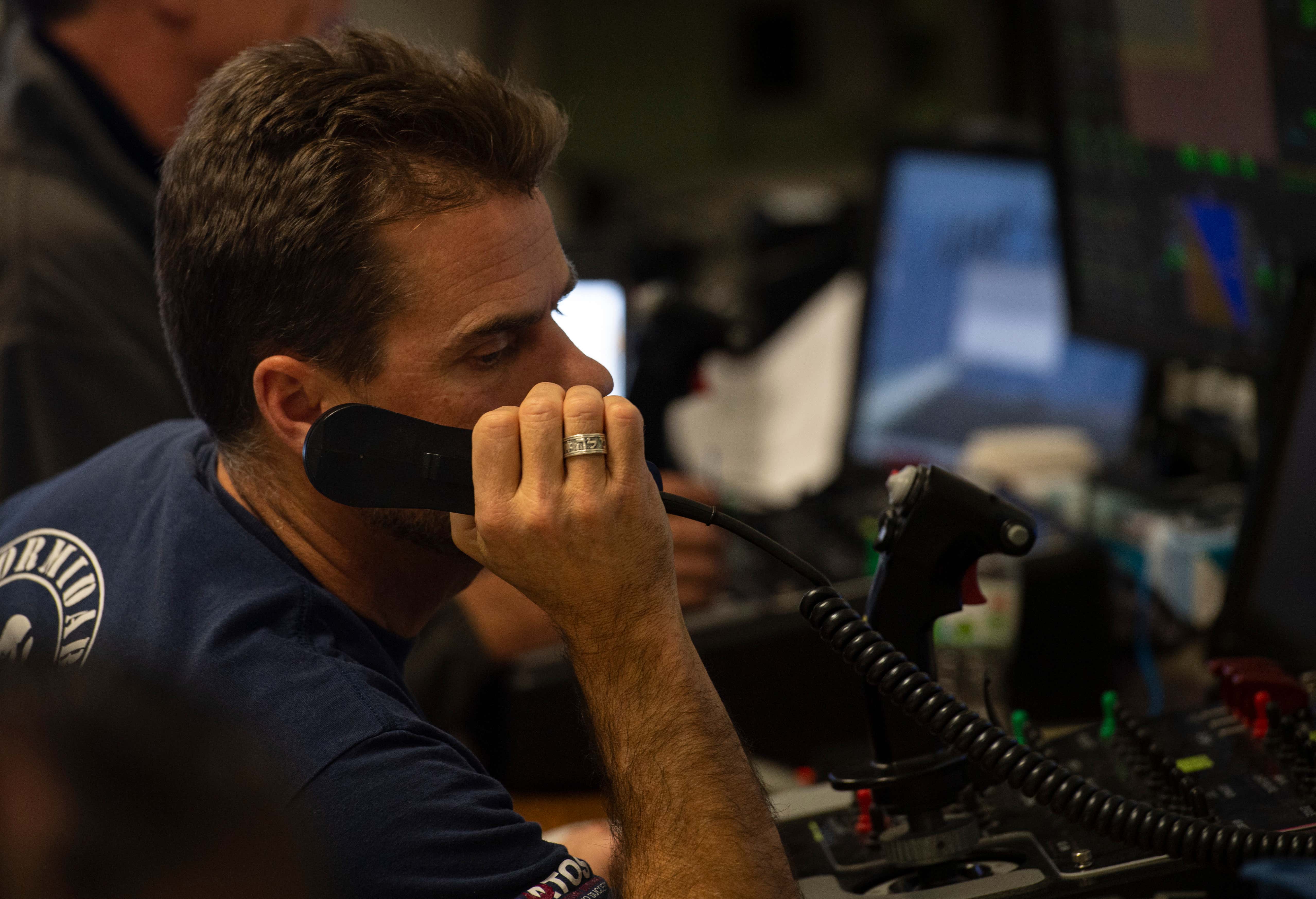
A remote control operator speaks into a radio at the U.S. Army Yuma Proving Ground, Arizona, during an XQ-58A Valkyrie test flight, December 9.
As well as the interactions between manned fighters and the XQ-58A drone, a portion of the testing at Yuma also involved a KC-46A Pegasus tanker setting up a communications pathway to a ground node using commercial internet routing standards via the Tactical Targeting Network Technology (TTNT) waveform. The same technology was also used to allow a pilot on board an F-35B to transmit full-motion video to a ground controller.
TTNT, which was originally developed for the U.S. Navy’s EA-18G Growler, has also been used in other semi-autonomous flight tests, including one in which an AV-8B Harrier jump jet employed a datalink using this waveform to communicate with a UTAP-22 drone, another Kratos product, acting as a loyal wingman.
“If fifth-generation platforms are going to be quarterbacks of a joint-penetrating team, we have to be able to communicate with those quarterbacks in an operationally relevant manner and enable data sharing between them, to them, and from them,” Preston Dunlap, the Department of the Air Force's "Chief Architect," explained. “For years people said it couldn’t be done. Today the team turned another page toward making the impossible possible. In just 12 months, the team has opened the door to a world where we can put the power of an operations center into the cockpit at the tactical edge.”
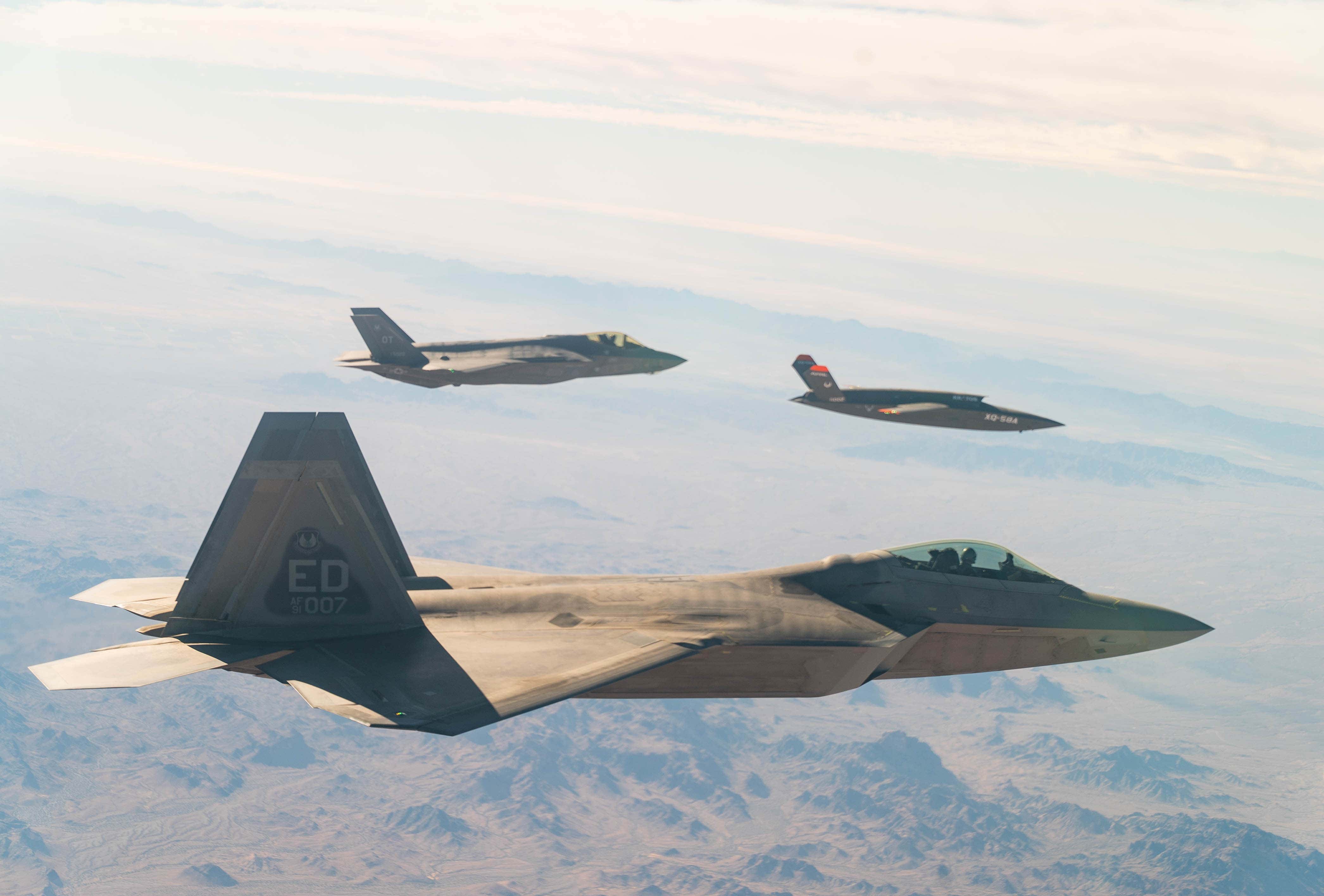
XQ-58, F-22, F-35 fly alongside each other.
Ground tests of gatewayONE began in December 2019. For these trials, information was passed between IFDLs on F-22s and MADLs on F-35s, as a proof of concept. During this phase of experiments, it is understood that the system was installed on a test stand on the ground, while Raptors and Joint Strike Fighters flew above, sending information through it.
The War Zone had previously considered what might come after these subsequent flight tests, at least once the gatewayONE technology could be successfully proven, without any connectivity loss. Options for the future could still include integrating this payload onto other platforms, both manned and unmanned. In this way, the technology could play a gateway role similar in some general respects to the existing Battlefield Airborne Communication Node (BACN), which can handle a wide variety of waveforms, including Link 16 and the Situational Awareness Data Link (SADL), the latter being another popular U.S. military data transfer system.
The Air Force has operated manned Bombardier E-11A and unmanned EQ-4B Global Hawk aircraft equipped with BACN for years now, but that gateway does not have the ability to translate between IFDL and MADL. The service also has a number of roll-on, roll-off communications kits designed to be used on the KC-135 aerial refueling tanker, including a system known as the Roll-On Beyond-line-of-sight Enhancement (ROBE), which can create an active net over the battlespace to help relay information sent via various datalinks.

The E-11A BACN is based on the Bombardier Global Express business jet platform.
The inclusion of a KC-46A using a TTNT datalink in the recent flight tests out at Yuma underscores the Air Force's interest in expanding the ability of its tanker fleets to also act as communications and data-sharing nodes. Assistant Secretary Roper has said that the first capability developed under ABMS could be releaseONE, a podded system under development for the Pegasus, as well as the KC-135, that could help push updated mission planning data, crafted in part using artificial intelligence-driven algorithms, to combat aircraft mid-mission.
Tankers equipped with releaseONE would send that information along to various platforms, such as XQ-58As equipped with gatewayONE, "that are doing the ‘Babel Fish’ translation to F-35s and F-22s that may be too far into the [anti-access, area-denial] bubble," Roper said in an interview with Air Force Magazine, making a reference to a fictional species of fish capable of translating any language from the universe of The Hitchhiker’s Guide to the Galaxy.
The Air Force and Lockheed Martin have also been testing the U-2S Dragon Lady spy plane as a communications hub on an experimental basis. In a 2019 test known as Project Riot, a U-2S acted as a transfer node between an F-35 and a ground control station. More recently, a U-2 demonstrated the ability to remotely use computers on the ground to help process data from onboard sensors and other systems in flight. In the future, however, it is planned that the U-2 and other aircraft will be able to receive updates for their mission computers in mid-air, as well as have the ability to establish links to offboard computers on the ground to provide additional processing power, something you can read all about in this recent exclusive War Zone report.
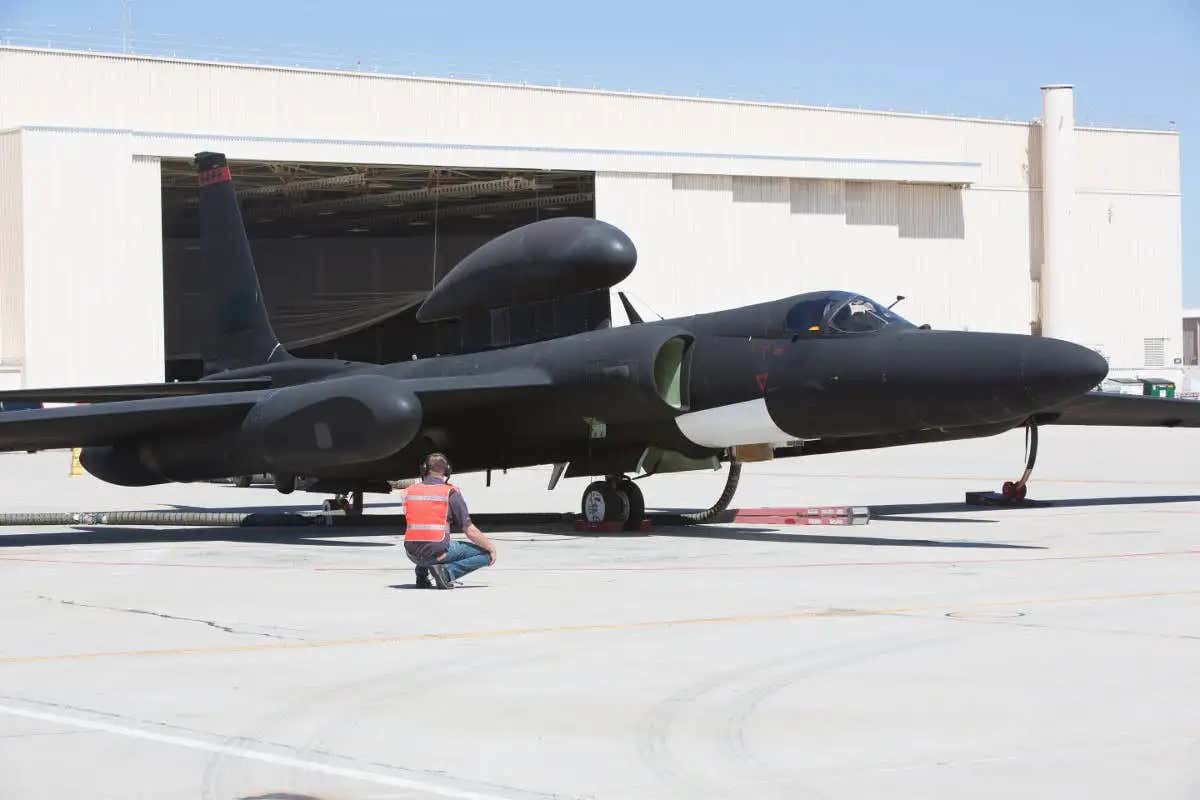
A U-2S Dragon Lady fitted with an experimental communications system, identified by the white section underneath the forward fuselage and the gold-colored antenna.
Even if the gatewayONE technology serves only to allow F-22s and F-35s to rapidly exchange data with each other, while still maintaining their stealthy characteristics, that would be massively significant. Since both these aircraft are equipped already with extremely capable sensor suites, their situational awareness and cooperative lethality would be enhanced dramatically by being able to share that sensor info. Placing this package on a stealthy drone is critical as its presence would not be an outright liability for the F-35s and F-22s operating in contested airspace and it could fly within line-of-sight throughout their cooperative sorties providing this essential data-sharing capability.
This was all underscored by the first-ever formation flight of an XQ-58A together with an F-22 and and F-35A as part these recent tests at Yuma. "The Valkyrie met 80% of the overall flight test objectives with 100% of the formation flying objectives being met before safely landing in the Arizona desert," the Air Force said of that portion of that experiment.
"This was the fifth successful launch of the Valkyrie, but the first time the platform has integrated a new warfighting capability payload and flown in formation with an F-22 and F-35," Michael Wipperman, the XQ-58A Program Manager at AFRL, said in a statement.
The recent flight trials are also a boost for the XQ-58A and will likely help inform the kind of communications networks that will be needed to realize longstanding ambitions to field loyal wingman drones, whether based on the Valkyrie, or other platforms. This unmanned aircraft would seem to be an ideal fit as a gatewayONE-equipped data relay operationally.
The XQ-58A is intended to be attritable, meaning that it is low-cost enough to be employed in scenarios where there is an increased risk of the drone being lost. As such, Valkyries, in general, would be a very viable option for use as loyal wingmen to work alongside F-22s and F-35s, as well as future penetrating combat aircraft, inside contested airspace.
In the same way, XQ-58As carrying gatewayONE datalinks could be a key link between swarms of other drones operating in denied areas and other platforms, including F-35s and F-22s. With this communications and data-sharing gateway available, each of the individual drones in swarm would not have to be equipped with this level of equipment, saving weight and payload space for other systems or weapons. This could also allow a swarm of drones to interact with multiple types of manned assets equipped with disparate datalinks during a single mission, as well.
"This was just a first step at demonstrating the potential of the force multiplier effects of attritable aircraft in a manned/unmanned environment," Air Force Brigadier General Heather Pringle, head of AFRL, said after the tests at Yuma.
“The XQ-58A modularity and ability to carry robust payloads enabled the rapid capability integration into an attritable experimentation vehicle," Wipperman, the XQ-58A Program Manager, added. "We’re thrilled with the seamless integration and demonstration of this flight. We look forward to continued capability enhancement at future demonstrations."
All told, the recent tests involving the XQ-58A and gatewayONE, as well as all the other assets out at Yuma, represent significant milestones in those programs, as well as critical steps forward for the Air Force's larger future battlespace networking plans now taking shape under ABMS. Above all else, The XQ-58A and gatewayONE pairing could be the best solution yet for giving America's two stealth fighters a universal translator for which to communicate through, one that can follow them deep inside enemy airspace if called upon to do so.

Stealthy XQ-58 Drone Busts The Networking Logjam Between F-22 And F-35
During a major test, the drone acted as an airborne translator for the F-22 and F-35, while also flying in formation alongside them.


